
1984 Essendon Premiership Poster in Excellent Condition
Essendon: 1984 original Weg Premiership poster; very fine condition.

1980 Richmond Weg Premiership Poster - Good Condition - Original
Richmond: 1980 original Weg Premiership poster; good condition.

Original Carlton Premiership Posters: 1979, 1981, 1982 - Mixed Condition
Carlton: 1979, 1981 and 1982 original Weg Premiership posters; mixed condition. (3).
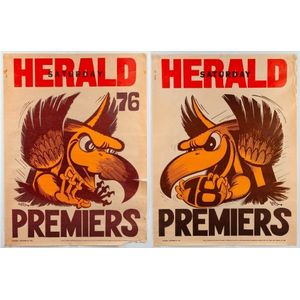
1976 and 1978 Hawthorn Weg Premiership Posters with Minor Flaws
Hawthorn: 1976 and 1978 original Weg Premiership posters; minor faults (2).
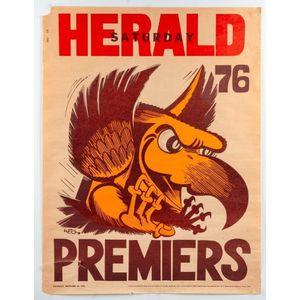
1976 Hawthorn Weg Premiership Poster with Minor Imperfections
Hawthorn: 1976 original Weg Premiership poster; small faults.
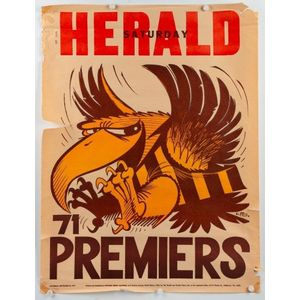
1971 Hawthorn Original Weg Premiership Poster with Minor Imperfections
Hawthorn: 1971 original Weg Premiership poster; small faults.

St.Kilda 1966 Original Weg Poster - Laminated Vintage Art Print
St.Kilda: 1966 original Weg poster. Laminated.
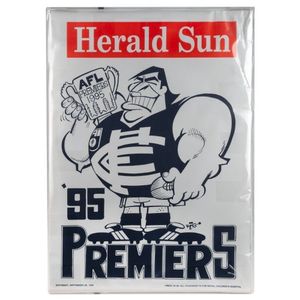
1995 Carlton Premiers Weg Posters - Superb Condition (100 Available)
1995 Carlton Premiers Weg Posters, (100) in superb condition.
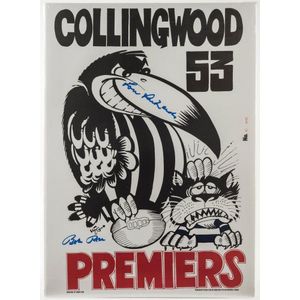
Collingwood '53 Premiers' Limited Edition Signed Poster (2002)
'Collingwood '53 Premiers' Weg Poster (printed in 2002), limited edition (C 0172) signed by Bob Rose and Lou Richards; overall 64 x 46 cm.

Bob Skilton Limited Edition Weg Art Poster - #167/250
South Melbourne - Bob Skilton signed limited edition Weg Art poster (artist ' Rogers) limited edition #167/250. Official WegArt Coa included. Framed: 84 x 65 cm.

1948 Melbourne Demons Premiership Team Signed Poster - Rare Find
Weg Melbourne Demons poster signed by six of the players from the 1948 Premiership team including Don Cordner, Billy Deans and George Bickford, 64 x 45.5 cm.

1995 Carlton Premiers Weg Posters - Superb Condition (100)
1995 Carlton Premiers Weg Posters, (100) in superb condition.
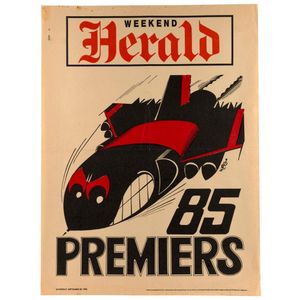
Essendon 1985 Original Weg Premiership Poster 67 x 50 cm
Essendon: 1985 original Weg Premiership poster. 67 x 50 cm
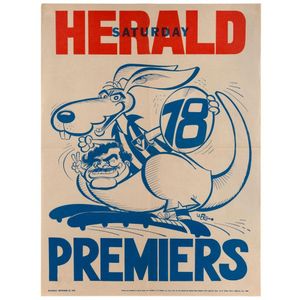
1978 North Melbourne Original Weg Losing Poster - Very Scarce
North Melbourne: 1978 original Weg 1978 losing poster, in very good condition. (Very scarce, as Hawthorn won the Grand Final.)

1976 Hawthorn Premiership Poster: Original, Very Good Condition, Small Tear
Hawthorn: 1976 original Weg Premiership poster. Very good condition but with small tear at top with no loss of paper or image. 66.5 x 50 cm.

Richmond 1974 Original Weg Premiership Poster with Minor Faults
Richmond: 1974 original Weg Premiership poster. Minor faults. 66.5 x 50 cm.
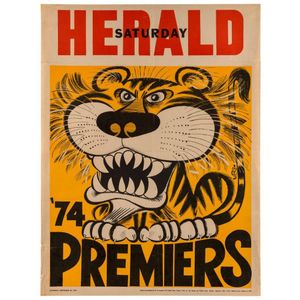
Richmond 1974 Weg Premiership Poster in Very Good Condition
Richmond: 1974 original Weg Premiership poster. Very good condition except for two small tears at left; no loss of paper or image. 66.5 x 50 cm.

1974 Grand Final Eve Poster: 'Alf's Tip' Original Prediction
1974 Grand Final Eve Poster: Undated 'Alf's Tip' original Weg prediction poster (published 27 September 1974) depicting a rampant Richmond Tiger sitting on top of a bruised and battered North Melbourne Kangaroo. (Alf Brown was correct in his prediction,…

1979 Weg Premiership Poster with Frame
1979 Weg Premiership poster; some faults mainly to upper left corner; framed, overall 72 x 56 cm.
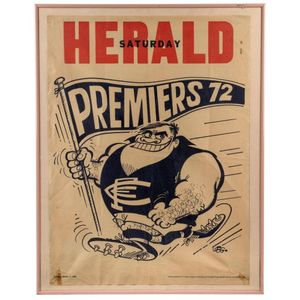
1972 Weg Premiership Poster - Framed and Glazed, 72x56cm
1972 Weg Premiership poster; some minor mounting faults to lower corners; framed & glazed, overall 72 x 56 cm.

1970 Weg Premiership Poster - Framed and Glazed - 72x57cm
1970 Weg Premiership poster, attractively framed & glazed, overall 72 x 57 cm.
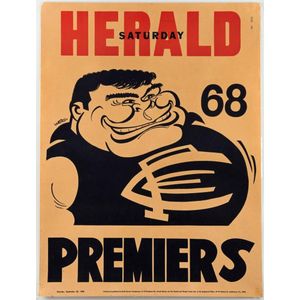
Vintage laminated Weg Premiership posters from 1968, 1981, and 1982
1968, 1981 & 1982 Weg Premiership posters; all laminated. (3).

Weg Posters 1998-2018 Collection
Weg posters: 1998, and 2000 to 2018 complete, very fine as issued. (20)

Melbourne Storm 1999 Premiers Weg Posters (11) - As New
Melbourne storm: 1999 Premiers original Weg posters (11). As new.
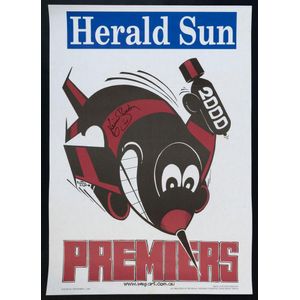
Signed Kevin Sheedy posters from 1993 and 2000
Essendon: original 1993 & 2000 Weg posters, both signed by Kevin Sheedy. Very good condition.
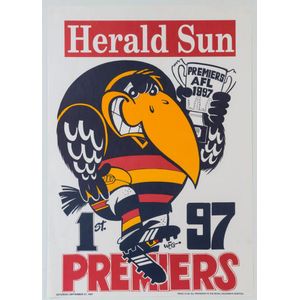
Laminated and duplicated AFL team posters (1992-1999)
Weg posters: laminated Weg posters for West coast Eagles 1992 & 1994, Essendon 1993 & Carlton 1995; also duplicated posters (not laminated) for Carlton 1995 (12), North Melbourne 1996 (9), Adelaide 1997 (11), Adelaide 1998 (6), North Melbourne 1999 (10).…

Signed Essendon Weg Poster by Kevin Sheedy
Essendon: original 1984 Weg poster, signed by Kevin Sheedy, good condition.
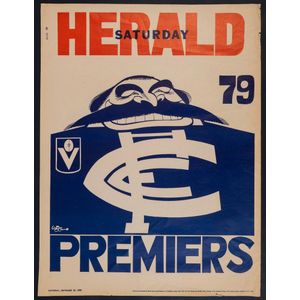
Vintage Carlton Weg Posters (3)
Carlton: 1979, 1981 & 1982 (internal tears) original Weg posters, some aging. Fair/Good condition. (3)

Hawthorn Original Weg Posters (1978-1989) - Set of 4
Hawthorn: 1978 (blemishes), 1986, 1988 & 1989 original Weg posters. Fair/Good condition overall. (4)

1976 Hawthorn Premiership Posters (Set of 4)
Hawthorn: 1976 original Weg Premiership posters, (4). Very good appearance but all with minor faults. Each 66.5 x 50 cm.
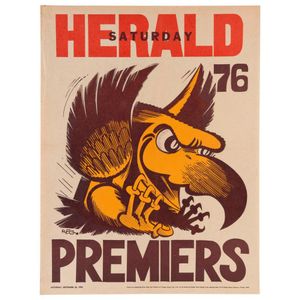
1976 Hawthorn Weg Premiership Poster - Excellent Condition
Hawthorn: 1976 original Weg Premiership poster. Very good condition. 66.5 x 50 cm.
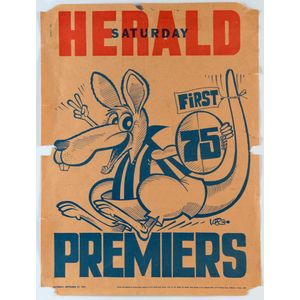
Sports Posters Collection with Football and Racing
Posters: with 1975 North Melbourne original Weg (faults), Weg limited edition 'Player Series' posters (5) for Carlton, Essendon, Geelong, Melbourne & Richmond, 1986 Melbourne & 1987 Brisbane bears team photo posters; also Collingwood; 1979 team photo…

1974 Richmond Weg Premiership Poster
Richmond: 1974 original Weg Premiership poster. Very good condition. 66.5 x 50 cm.
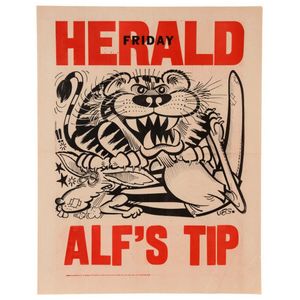
1974 Grand Final Prediction Poster: Richmond vs North Melbourne
1974 Grand Final eve poster: Undated 'Alf's Tip' original Weg prediction poster (published 27 September 1974) depicting a rampant Richmond tiger sitting atop a bruised and battered North Melbourne kangaroo. (Alf brown was correct in his prediction, with…

1974 Richmond Premiership Poster - Fair/Good Condition
Richmond: 1974 original Weg Premiership poster; edge faults with 6 cm tear at lower left, overall fair/good condition.

1974 Richmond Weg Premiership Poster
Richmond: 1974 original Weg Premiership poster. Very good condition except for a minor loss to top margin. 66.5 x 50 cm.
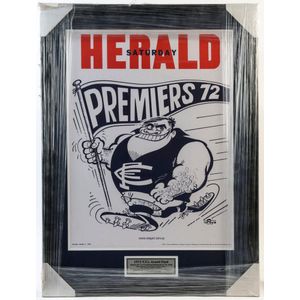
Carlton 1972 Premiership Poster, Framed & Glazed
Carlton: 1972 reprint Weg Premiership poster by Wegart; attractively framed and glazed, overall 87 x 65 cm.

Hawthorn 1961 Weg Poster, Framed and Glazed
Hawthorn: 1961 original Weg poster, reduced at top ('Saturday Herald' excised); internal closed tear, Fair/Good condition; framed & glazed, overall 64 x 52 cm.
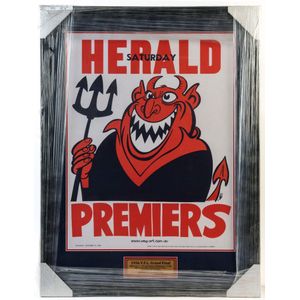
1956 Melbourne Premiership Poster
Melbourne: 1956 reprint Weg Premiership poster by Wegart; attractively framed and glazed, overall 87 x 65 cm.
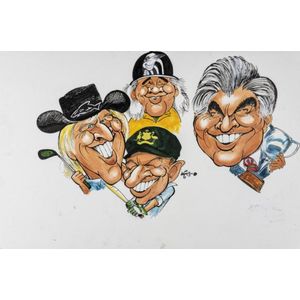
Sports Legends Artwork Signed by Artist
Artwork & prints Weg original artwork featuring Don Bradman, Greg Norman, Bart Cummings & Joffa Corfe (leader of Collingwood cheer squad), signed by artist within image, overall 76 x 51 cm.
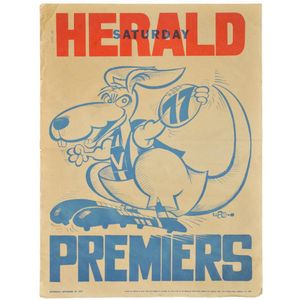
1977 North Melbourne Weg Poster - Fair/Good Condition
North Melbourne: 1977 original Weg poster, Fair/Good condition with some peripheral faults.
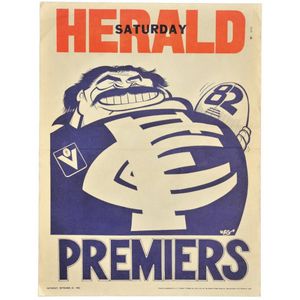
Vintage Weg Posters (1972-1982) - Set of 4
Carlton: original Weg posters for 1972, 1979, 1981 & 1982. Fair/Good condition (1972 with tear at top and peripheral tape stains). (quantity 4 items)

Weg Art Sets: Premiers & Footy Legends (340+)
2001-07 Weg Art sets, comprising Premiers sets for 1980, 1984, 1989 (2), 1990 (2), 1992, 1994, 1995, 2000 & 2005; Footy Legends 1 (2), 2 & 3, mainly Fine/Very fine. (quantity 340+)

Dustin Martin Canvas and Swans Poster
Dustin Martin: Richmond: large canvas print image of 'Dusty' kicking for goal, mounted onto a wooden frame, overall 115 x 75 cm, also a 2005 Weg Premiership poster for Sydney swans, framed and glazed. (2 items).

Signed Richmond Tigers 1943 Weg Caricature Poster with Certificate
Richmond: 'Tigers 1943 Premiers' commemorative Weg caricature poster, signed by Jack Dyer, with solicitor's certificate of authenticity, framed and glazed, overall 69 x 50 cm.

Richmond's Weg Posters: Celebrating 10 Premiership Wins
Richmond: c.1990s Weg posters for Richmond Premiership wins in 1920, 1921, 1932, 1934, 1943, 1967 1969, 1973, 1974 & 1980. (10).
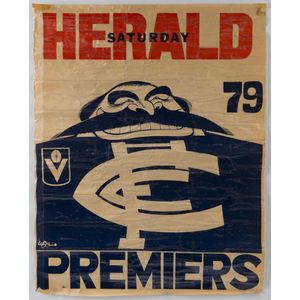
Carlton Premiership Posters Collection
Carlton: posters: comprising 1979 Carlton Premiership Weg poster (laminated, condition), 1999 Craig Bradley testimonial year signed by Bradley, Stephen Kernahan & Scott Camporeale, 1999 unsigned poster celebrating Carlton Premierships featuring images of…
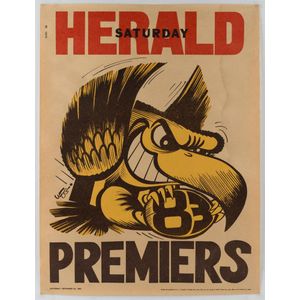
1983 Hawthorn Premiership Posters with Water Damage
Hawthorn: 1983 original Weg Premiership posters, (2), both with slight water damage.
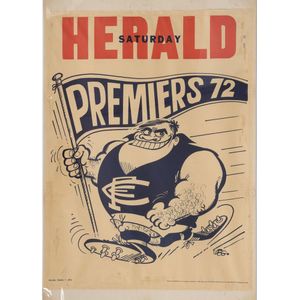
Carlton Premiership Posters Collection
Carlton: 1972, 1982 & 1987 'Premiers' Weg posters, edges glued to backing boards, all with protective plastic sleeves, also a laminated 1995 'Premiers' poster. G/VG condition. (4 items).

1966 St Kilda Premiership Poster
St Kilda: 1966 original Weg premiership poster, tear and associated defects at top, window mounted, framed & glazed, overall 67 x 85 cm.

1966 St Kilda Premiership Original Poster - Excellent Condition
St Kilda: 1966 original Weg premiership poster, light folds, 51 x 67 cm. Superior condition to the examples usually offered. A defective and stained example of this poster sold for $2,600+ (including. Comms) in our November 2020 sporting memorabilia sale.

Signed Paul Kelly Swans Captain Original Artwork
Sydney: 2002 (circa) original Weg artwork of the Swans' captain Paul Kelly, signed by Paul Kelly & Weg, window mounted, framed & glazed, overall 53 x 68 cm.

Signed Tony Lockett artwork by Weg, framed and glazed
Sydney: 1999 (circa) original Weg artwork of Tony Lockett titled 'Plugger', signed by Weg, window mounted, framed & glazed, overall 52 x 67 cm.

Weg's Rare Cat Cartoon Poster from 1963 Geelong Herald
Geelong: 1963 original Weg poster, 'Herald' trimmed from top, but Weg's cat cartoon is fine, and would look fabulous framed. Extremely rare.

Signed Weg Artwork for Retirements of Sheedy & Hird
Essendon: Original preliminary Weg artwork for the retirements of Kevin Sheedy & James Hird in 2007, signed by Weg, Kevin Sheedy completed in red & black ink, majority of James Hird in pencil; with an example of the completed poster (numbered 237/500),…
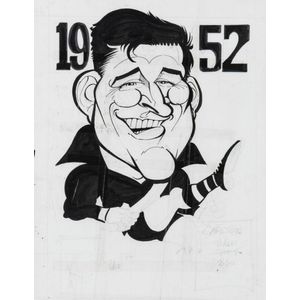
Essendon Brownlow Medallists Artwork & Posters
Essendon: Original preliminary artwork for Weg poster for 1952 Brownlow Medallist Bill Hutchison, framed & glazed, overall 59 x 93 cm. Artwork has some repairs, as it was used by Weg as a cutting board. Together with framed Weg Brownlow Medal posters for…
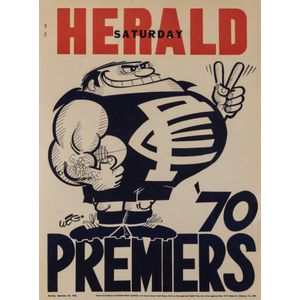
Carlton Weg Posters and Newspaper Pages Collection
Carlton: 1970 Weg poster laminated; 1979 Weg posters laminated (3); Weg posters for 1981, 1987 & 1995 (7); 1906-47 retrospective Weg posters (8); other posters (3); laminated newspaper pages (2). (Qty 26 items)

Weg and Knight Premiership Posters Collection
A collection of Weg or Wegart posters comprising of 1989, 1991, 1998 (2), 1999 (2), 2010, 2018 (2), Lockett 1300 Goals (with cert.). Also, Herald-Sun premiership posters by Mark Knight: 2011, 2012, 2013 (2) and 2018. (Total: 15).

Weg Premiership Posters (1988-1991) - Set of 3
Hawthorn: 1988, 1989 and 1991 original Weg premiership posters, (3), mixed condition.
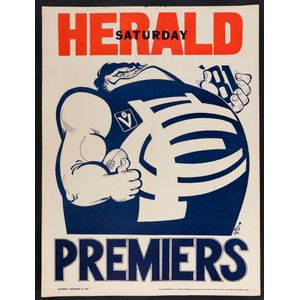
1982 Weg Posters (2) with Slight Aging
Carlton: 1982 original Weg posters, (2) both with slight paper ageing.
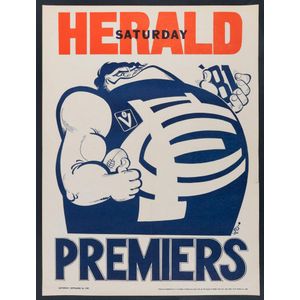
1981 Weg Premiership Carlton Posters (Set of 5)
Carlton: 1981 original Weg Premiership posters, (5 examples). Mainly good condition. Each 66.5 x 50 cm.

1981 Carlton Weg Premiership Poster
Carlton: 1981 original Weg Premiership poster. Good condition. 66.5 x 50 cm.
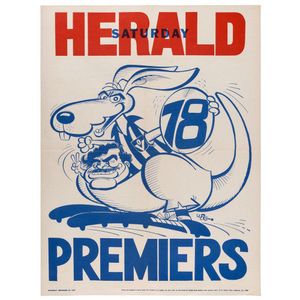
1978 North Melbourne Weg Poster - Grand Final Losers
North Melbourne: 1978 original Weg poster for the team that lost the Grand Final, in very good condition. 66 x 49.5 cm. Hawthorn defeated North Melbourne in the Grand Final.

1976 Hawthorn Premiership Poster
Hawthorn: 1976 original Weg Premiership poster. Very good condition. 66.5 x 50 cm.

1974 Richmond Weg Premiership Poster, Excellent Condition
Richmond: 1974 original Weg Premiership poster. Very good condition. 66.5 x 50 cm.
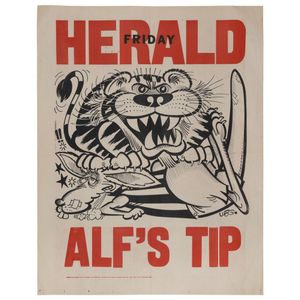
1974 Grand Final Eve Poster: Richmond vs North Melbourne Prediction
1974 Grand Final Eve Poster: Undated 'Alf's Tip' original Weg prediction poster (published 27 September 1974) depicting a rampant Richmond Tiger sitting atop a bruised and battered North Melbourne Kangaroo. (Alf Brown was correct in his prediction, with…

St. Kilda's 1971 Preliminary Final Win Poster
St. Kilda Preliminary Final: 18 September 1971 original Weg poster for St. Kilda's preliminary final win over Richmond. The pink paper stock indicating that the news covered by the poster was 'late breaking'. Extremely scarce, in fact, only the second…

1966 St. Kilda Premiership Poster with Minor Damage
St. Kilda: 1966 original Weg premiership poster, repaired tear and some staining but no paper losses.
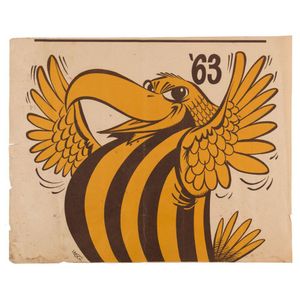
Rare 1963 Hawthorn Premiership Poster - Weg's Central Section
Hawthorn: the central section of Weg's 1963 premiership poster (with 'Herald' and 'Premiers' excised) for the losing team. Fair/Good condition. A great rarity, we have previously sold this example and know of no others. 41 x 51 cm. The 1963 Grand Final,…

Rare 1958 Collingwood Premiership Poster in Fair Condition
Collingwood: 1958 Weg Premiership poster, fair condition with minor repairs evident on reverse. Rarely seen in any condition.
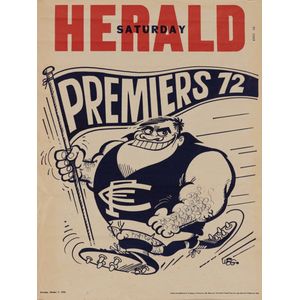
1972 Weg Poster in Fine Condition
Carlton: 1972 original Weg poster, fine condition (minor creasing). Scarce and attractive.
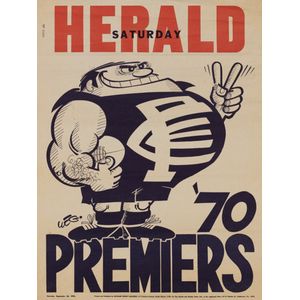
1970 Weg Poster - Carlton
Carlton: 1970 original Weg poster. Good condition (minor tone spots). Scarce and attractive.
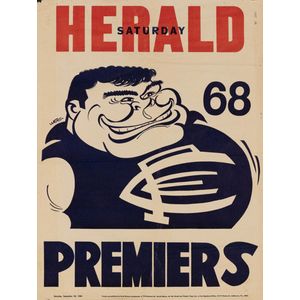
1968 Weg Poster: Carlton in Fine Condition
Carlton: 1968 original Weg poster. Fine condition (minor peripheral fault top left). Scarce and attractive.
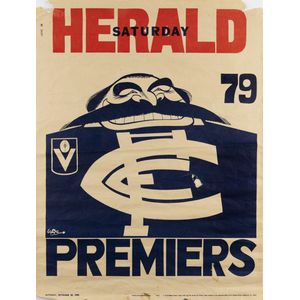
Weg AFL Posters Collection - 5 Items
Posters original Weg posters for 1979 Carlton (corner faults); 1982 Carlton (repaired hole); 1986 Hawthorn; Weg caricature poster for 1958 Collingwood (laminated); also 'Essendon Gazette' poster for 1985 Essendon. (Qty 5)

1993 Sydney Swans Cloth Weg Poster
Sydney Swans: 1993 cloth Weg Poster, slightly crumpled, pinholes in corners, good condition overall.

1980 Weg Poster - Richmond Cityscape
Richmond: 1980 framed original Weg poster. Fair/Good condition, overall 56.5 x 75 cm.

1978 North Melbourne Grand Final Losing Poster
North Melbourne: 1978 original Weg 1978 losing poster, in very good condition. 66 x 49.5 cm. Hawthorn defeated North Melbourne in the Grand Final.

Captain Blood Poster Artwork with Evaluation
Captain Blood' Jack Dyer 'Eat em alive Tiges!' original artwork for a poster, framed, overall 103 x 81 cm. With an original Weg's World Evaluation [2004].

1976 Hawthorn Premiership Posters (Set of 4) - Defective
Hawthorn: 1976 original Weg Premiership posters, (4). 66.5 x 50 cm. All with defects.

1973 Weg Poster: Richmond
Richmond: 1973 framed original Weg poster. Good condition, overall 56.5 x 75 cm.

St. Kilda's 1971 Preliminary Final Win Poster
St. Kilda Preliminary Final: 18 September 1971 original Weg poster for St. Kilda's preliminary final win over Richmond. The pink paper stock indicating that the news covered by the poster was 'late breaking'. Extremely scarce, in fact, the first example…

Weg & Blues Posters Collection
Carlton: original Weg posters for 1970 (corner fault), 1979 (2), 1981, 1982 (2) && 1995 (2), also 1982 Gf 'The Mighty Blues' poster (edge faults) & Football Record 'Doully's Big Day' posters (2), overall Fair/VG condition. (11 items)

Carlton Weg Posters (1968-1981) - Set of 5
Carlton: 1968, 1969, 1970, 1979 & 1981 original Weg posters, all mounted and affixed to backing boards. (5).

St Kilda Original 1966 Weg Poster, Framed & Signed
St Kilda: 1966 original Weg poster, framed & glazed, with Weg signature on frame, overall 54 x 70 cm. Poor/Fair condition (laid down with some repairs), though looks attractive in frame.

Vintage Richmond Football Club Posters
Richmond: Weg poster 'Hungry! 400' (Kevin Bartlett's 400th game in 1983); plus 1964 Heinz posters for Pat Guinane & Neville Crowe. Fair/Good condition. (Qty 3)

Hawthorn Premiers Posters Collection
Hawthorn: Weg posters for 1978, 1983, 1986, 1988 & 1989; also posters 'Mighty Hawks Premiers 86' & Rogers 'The Mighty Hawks Premiers' for 1989 & 1991. Fair/Good condition. (Qty 8)

Rare Hawthorn 1963 losing Weg poster for auction
Hawthorn: Central portion of 1963 losing Weg poster (with 'Herald' & 'Premiers' excised). Fair/Good condition. A great rarity. Sold at another Melbourne auction in 2016 for $3416.

Footscray Ephemera Collection: Posters, Photographs, Newspapers, and Memorabilia
Footscray: Ephemera collection in two folders, including Noel posters (28 - with 16 signed by players), Harv posters (3), Brocker posters (2), Rogers posters (2), Weg player posters (2); range of photographs with 2 signed - Chris Grant & Adam Cooney;…
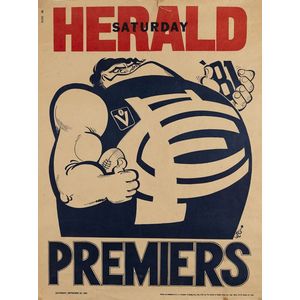
Carlton Football Club Posters Collection
Carlton: Weg posters for 1981 (2) & 1982; also posters '79 Grand Final - The Blues' & 1982 Sunday Press 'Blues!'; Fair/Good condition. (Qty 5)

1985 Essendon Weg Premiership Poster - Excellent Condition
Essendon: 1985 original Weg Premiership poster. Very good condition.


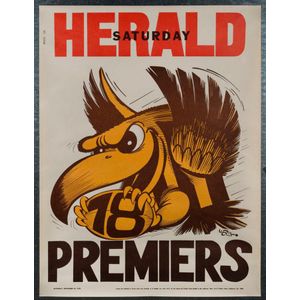

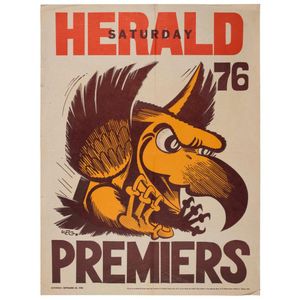

 Loading more...
Loading more...